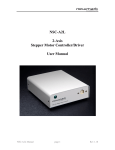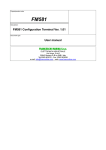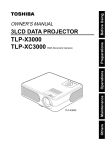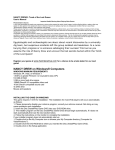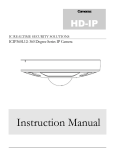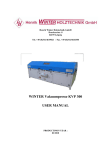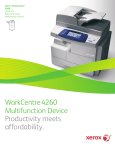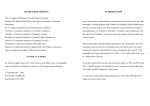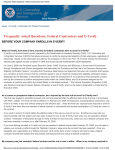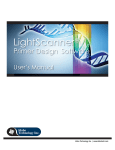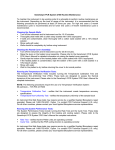Download Modbus_Addition_Addendum_A_Rev_1.02 (1)
Transcript
Communication Add-on Modbus - RTU Addendum A Modbus - RTU Addendum A page 2 rev 1.02 COPYRIGHT © 2008 ARCUS, ALL RIGHTS RESERVED First edition, October 2008 ARCUS TECHNOLOGY copyrights this document. You may not reproduce or translate into any language in any form and means any part of this publication without the written permission from ARCUS. ARCUS makes no representations or warranties regarding the content of this document. We reserve the right to revise this document any time without notice and obligation. Revision History: 1.00 – 1st Release 1.01 – Added RSM 1.02 – Updated bookmarks Modbus - RTU Addendum A page 3 rev 1.02 Table of Contents 1. Introduction ..................................................................................................................... 5 2. Communication Settings ................................................................................................. 6 Baud Rate ........................................................................................................................ 6 Modbus Device Number ................................................................................................. 6 RS-485 Communication Mode ....................................................................................... 6 3. Sample Usage.................................................................................................................. 8 Achieving functionality via variables ............................................................................. 8 Standalone Example Program 1 ...................................................................................... 8 4. Modbus RTU Addressing ............................................................................................... 9 Data Model...................................................................................................................... 9 Holding Registers – Read/Write – 16 bits ...................................................................... 9 Dealing with the Swapped-Long Registers................................................................... 11 4. Modbus GUI ................................................................................................................. 12 Connection Configuration ............................................................................................. 13 Main Screen .................................................................................................................. 13 Modbus - RTU Addendum A page 4 rev 1.02 1. Introduction The Modbus-RTU protocol runs over the RS-485 communication medium. For tips regarding setting up a RS-485 network, see the user manual specific to your controller. The Arcus implementation of Modbus-RTU supports the holding register data type only. Coils, Discrete Inputs and Input Registers are not supported. Modbus - RTU Addendum A page 5 rev 1.02 2. Communication Settings Baud Rate The RS-485 baud rate can be changed using the DB command. Please note that the device baud rate must be within the range [1, 5]. Device Baud Value 1 2 3 4 5 Baud Rate (bps) 9600 19200 38400 57600 115200 To write the values to the device’s flash memory, use the STORE command. After a complete power cycle, the new baud rate will be written to memory. Note that before a power cycle is completed, the settings will not take effect. By default: Baud rate is set to: 1 (9600 bps) This setting can be made either through RS-485 ASCII or USB communication depending on your controller. Modbus Device Number Arcus Modbus controllers allow the user to set the Modbus device number (used for addressing) from the range of [1-127]. In order to make this change, use the DNM command. To write the values to the device’s flash memory, use the STORE command. After a complete power cycle, the new device number will be written to memory. Note that before a power cycle is completed, the settings will not take effect. By default: Modbus device number is set to 1 This setting can be made either through RS-485 ASCII or USB communication depending on your controller. RS-485 Communication Mode Changing from RS-485 to Modbus By default, Arcus controllers are configuring for ASCII protocol when using RS-485 communication. In order to enable Modbus-RTU communication, set RSM=1. Modbus - RTU Addendum A page 6 rev 1.02 To write the values to the device’s flash memory, use the STORE command. After a complete power cycle, the communication mode setting will be written to memory. Note that before a power cycle is completed, the settings will not take effect. This setting must be made through RS-485 ASCII. Below is a table of the ASCII commands that are mentioned above. To see a complete list of all ASCII commands, see the user manual specific to your controller. Command DB Description Return the current baud rate of the device DB=[1,2,3,4,5] DNM DNM=[1-127] RSM Set the baud rate of the device Get Modbus device number Set Modbus device number Get RS-485 Communication mode Return 1 – 9600 bps 2 – 19200 bps 3 – 38400 bps 4 – 57600 bps 5 – 115200 bps OK [1-127] OK 0 – ASCII RSM=[0,1] STORE Set RS-485 Communication mode Store settings to flash OK OK 1 – Modbus-RTU Changing from Modbus to RS-485 Once your controller is in Modbus communication, it can no longer accept ASCII commands. In order to change communication back to ASCII, you must write the value 1 into register V30. After writing to register V30, a power cycle must be performed before the setting takes effect. Note that the setting is automatically stored to flash when written. See “Modbus RTU Addressing” for details on how to write the value. Modbus - RTU Addendum A page 7 rev 1.02 3. Sample Usage Achieving functionality via variables Only the general purpose variables V1-V30 of the controller are accessible via ModbusRTU communication. By reading/updating these variables, the desired functionality can be achieved by referencing them within a running stand-alone program. For details regarding stand-alone programming, see the user manual specific to your controller. In a typical application, the controller runs a stand-alone program while the Modbus master accesses variables over the Modbus-RTU protocol. The following is a sample of such a stand-alone program. Standalone Example Program 1 EO=1 ;* Enable the motor power WHILE 1=1 GOSUB 1 IF V1=1 X1000 WAITX ELSEIF V1=2 X3000 WAITX ELSEIF V1=3 X0 WAITX ENDIF ;* Forever loop ;* Set speed settings V2 = PX ENDWHILE ;* If V1 is set to 1 then go to position 1000 ;* Wait for move to complete ;* If V1 is set to 2 then go to position 3000 ;* Wait for move to complete ;* If V1 is set to 3 then go to position 0 ;* Wait for move to complete ;* Store pulse position in V2 ;* Go back to WHILE statement END SUB 1 HSPD=V4 LSPD=V5 ACC=V6 END SUB Modbus - RTU Addendum A ;* Set the high speed to V4 pulses/sec ;* Set the low speed to V5 pulses/sec ;* Set the acceleration to V6 msec page 8 rev 1.02 4. Modbus RTU Addressing The Arcus implementation of Modbus-RTU supports the holding register data type only. Coils, Discrete Inputs and Input Registers are not supported. Data Model Data Type Parameter 03h Size (Bits) 16 Data Type Description Holding Registers Access Address Range Read/Write [1-60] Holding Registers – Read/Write – 16 bits Address 1 2 3 4 5 6 7 8 9 10 11 12 13 14 15 16 17 18 19 20 21 22 23 24 25 26 27 Name V1_H V1_L V2_H V2_L V3_H V3_L V4_H V4_L V5_H V5_L V6_H V6_L V7_H V7_L V8_H V8_L V9_H V9_L V10_H V10_L V11_H V11_L V12_H V12_L V13_H V13_L V14_H Modbus - RTU Addendum A Description V1 Higher 16 bits [31:16] V1 Lower 16 bits [15:0] V2 Higher 16 bits [31:16] V2 Lower 16 bits [15:0] V3 Higher 16 bits [31:16] V3 Lower 16 bits [15:0] V4 Higher 16 bits [31:16] V4 Lower 16 bits [15:0] V5 Higher 16 bits [31:16] V5 Lower 16 bits [15:0] V6 Higher 16 bits [31:16] V6 Lower 16 bits [15:0] V7 Higher 16 bits [31:16] V7 Lower 16 bits [15:0] V8 Higher 16 bits [31:16] V8 Lower 16 bits [15:0] V9 Higher 16 bits [31:16] V9 Lower 16 bits [15:0] V10 Higher 16 bits [31:16] V10 Lower 16 bits [15:0] V11 Higher 16 bits [31:16] V11 Lower 16 bits [15:0] V12 Higher 16 bits [31:16] V12 Lower 16 bits [15:0] V13 Higher 16 bits [31:16] V13 Lower 16 bits [15:0] V14 Higher 16 bits [31:16] page 9 rev 1.02 28 29 30 31 32 33 34 35 36 37 38 39 40 41 42 43 44 45 46 47 48 49 50 51 52 53 54 55 56 57 58 †59 †60 V14_L V15_H V15_L V16_H V16_L V17_H V17_L V18_H V18_L V19_H V19_L V20_H V20_L V21_H V21_L V22_H V22_L V23_H V23_L V24_H V24_L V25_H V25_L V26_H V26_L V27_H V27_L V28_H V28_L V29_H V29_L V30_H V30_L V14 Lower 16 bits [15:0] V15 Higher 16 bits [31:16] V15 Lower 16 bits [15:0] V16 Higher 16 bits [31:16] V16 Lower 16 bits [15:0] V17 Higher 16 bits [31:16] V17 Lower 16 bits [15:0] V18 Higher 16 bits [31:16] V18 Lower 16 bits [15:0] V19 Higher 16 bits [31:16] V19 Lower 16 bits [15:0] V20 Higher 16 bits [31:16] V20 Lower 16 bits [15:0] V21 Higher 16 bits [31:16] V21 Lower 16 bits [15:0] V22 Higher 16 bits [31:16] V22 Lower 16 bits [15:0] V23 Higher 16 bits [31:16] V23 Lower 16 bits [15:0] V24 Higher 16 bits [31:16] V24 Lower 16 bits [15:0] V25 Higher 16 bits [31:16] V25 Lower 16 bits [15:0] V26 Higher 16 bits [31:16] V26 Lower 16 bits [15:0] V27 Higher 16 bits [31:16] V27 Lower 16 bits [15:0] V28 Higher 16 bits [31:16] V28 Lower 16 bits [15:0] V29 Higher 16 bits [31:16] V29 Lower 16 bits [15:0] V30 Higher 16 bits [31:16] V30 Lower 16 bits [15:0] †V30 is reserved for communication mode setting. In order to change from Modbus communication to ASCII, set V30=1. Modbus - RTU Addendum A page 10 rev 1.02 Dealing with the Swapped-Long Registers Variables V1-V30 are 32-bit twos-complement numbers. Since standard Modbus holding registers only hold 16 bits, the full 32-bit numbers are stored into two different registers. The lower addressed register represents the higher 16 bits of the 32-bit number, while higher addressed register represents the lower 16 bits of the 32-bit number. This is known as swapped-long. Example 1: Set V1 to: -34930493 (0xFDEB00C3) V1 holding register is found at address 1. Set Holding Register Address 1 [bits 16:31] to 0xFDEB Set Holding Register Address 2 [bits 0:15] to 0x00C3 Example 2: Read V2 register V2 holding register is found Assuming that the values stored in these registers are: Holding Register Address 3 [bits 16:31] = 0x0000 Holding Register Address 4 [bits 0:15] = 0x4933 When reading this value, the full 32-bit value is: +18739 (0x00004933) Modbus - RTU Addendum A page 11 rev 1.02 4. Modbus GUI Arcus provides a GUI that allows Modbus communication to be achieved between a PC and the controller. Visit our website to download this software. www.arcus-technology.com Before running the program, make sure to register the 3rd party Modbus master driver on your PC. See instructions below: a. Download and extract GUI folder onto your PC. b. Using the command line, browse to the “mod102” directory within the GUI folder and type “mbserver.exe /regserver” and press enter. c. Note that if this process is not done correctly, you will receive the following error when trying to run the program. Modbus - RTU Addendum A page 12 rev 1.02 Connection Configuration After the 3rd party Modbus driver has been successfully registered, start the program and the following screen should show up. Select the correct COM port, Baud Rate and Slave ID (Modbus Device Number). The search function allows the user to search for a device on a COM port at a given baud rate. Main Screen The main screen allows the user to read/write variables V1-V30. Modbus - RTU Addendum A page 13 rev 1.02 Contact Information Arcus Technology, Inc. 3061 Independence Drive. Suite H Livermore, CA 94551 925-373-8800 www.arcus-technology.com Modbus - RTU Addendum A page 14 rev 1.02














